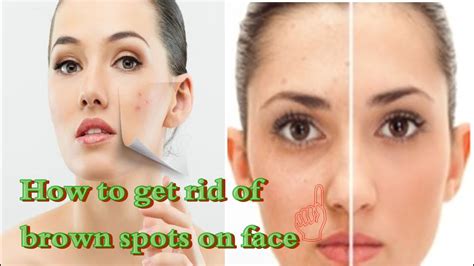How to Get Rid of Brown Spots on Your Face: A Comprehensive Guide
Brown spots, also known as hyperpigmentation, are a common skin concern affecting many. These dark patches can appear on the face, hands, and other sun-exposed areas due to various factors, including sun damage, hormonal changes, and aging. While completely eliminating brown spots might be challenging, several effective methods can significantly lighten them and improve your complexion. This guide explores various approaches to help you achieve clearer, more even-toned skin.
Understanding the Causes of Brown Spots
Before diving into treatment options, understanding the root cause of your brown spots is crucial. This allows for a more targeted and effective approach. Common causes include:
-
Sun Exposure: UV radiation is the most significant contributor to hyperpigmentation. Prolonged sun exposure without adequate protection leads to increased melanin production, resulting in the appearance of brown spots. This is why sun protection is paramount in preventing and managing brown spots.
-
Hormonal Changes: Fluctuations in hormone levels, particularly during pregnancy (melasma) and menopause, can trigger hyperpigmentation.
-
Aging: As we age, our skin's natural ability to regenerate slows down, leading to a higher chance of developing age spots (solar lentigines).
-
Inflammation: Skin inflammation from acne, eczema, or other conditions can also stimulate melanin production, resulting in post-inflammatory hyperpigmentation.
-
Genetics: Family history plays a role in the predisposition to hyperpigmentation.
Effective Treatments for Brown Spots
Numerous treatments can effectively lighten brown spots. The best approach depends on the severity of the spots and your skin type. Always consult a dermatologist for personalized advice before starting any treatment.
1. Topical Treatments:
-
Hydroquinone: This is a common ingredient in over-the-counter and prescription-strength products known for its ability to lighten brown spots. However, it can cause irritation in some individuals.
-
Retinoids: Retinoids, like retinol and tretinoin, are derivatives of vitamin A that promote cell turnover, helping fade brown spots and improve skin texture. Start with a low concentration and gradually increase as tolerated. Always use sunscreen with retinoids, as they increase sun sensitivity.
-
Vitamin C Serums: Vitamin C is a potent antioxidant that protects against free radical damage and can help brighten the skin. Look for serums with a high concentration of L-ascorbic acid.
-
Azelaic Acid: This natural acid gently exfoliates the skin, reducing hyperpigmentation and improving overall skin tone. It’s generally well-tolerated.
-
Kojic Acid: This naturally derived ingredient inhibits melanin production, helping to lighten brown spots.
2. Professional Treatments:
-
Chemical Peels: Chemical peels use various acids to exfoliate the skin's outer layers, revealing brighter, more even-toned skin beneath. The strength of the peel will be determined by your dermatologist based on your skin type and the severity of your hyperpigmentation.
-
Microdermabrasion: This minimally invasive procedure uses tiny crystals to exfoliate the skin's surface, improving skin texture and reducing the appearance of brown spots.
-
Laser Treatments: Different types of laser treatments target hyperpigmentation, effectively breaking down melanin and promoting skin regeneration. This is a more intensive treatment requiring professional expertise.
-
Intense Pulsed Light (IPL): IPL therapy uses intense pulses of light to target brown spots and improve skin tone.
3. Home Remedies & Lifestyle Changes:
While these methods might not offer dramatic results, they can complement professional treatments and contribute to overall skin health:
-
Sunscreen: Daily use of broad-spectrum sunscreen with an SPF of 30 or higher is crucial, regardless of the treatment you choose. This prevents further sun damage and helps protect against new brown spots.
-
Gentle Exfoliation: Regular gentle exfoliation with a chemical exfoliant (like AHAs or BHAs) can help remove dead skin cells, revealing brighter skin. Avoid harsh scrubbing.
-
Hydration: Keep your skin well-hydrated by drinking plenty of water and using a moisturizer suitable for your skin type.
Choosing the Right Treatment
The best approach to treating brown spots is highly individualized. Consult a dermatologist to discuss your options and develop a personalized treatment plan. They can assess your skin type, the severity of your hyperpigmentation, and any underlying medical conditions to recommend the most effective and safe treatment strategy. Be patient, as it often takes time to see noticeable results. Consistency with your chosen treatment and sun protection is key to achieving a clearer, more even complexion.
